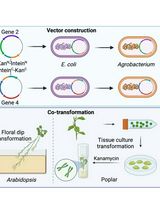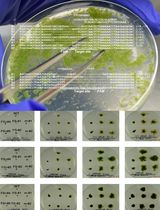- EN - English
- CN - 中文
Production of Guide RNAs in vitro and in vivo for CRISPR Using Ribozymes and RNA Polymerase II Promoters
利用核酶和RNA聚合酶II启动子体内及体外合成CRISPR系统的引导RNA
(*contributed equally to this work) 发布: 2017年02月20日第7卷第4期 DOI: 10.21769/BioProtoc.2148 浏览次数: 18633
评审: Rainer MelzerDiarmuid Seosamh Ó’MaoiléidighAnonymous reviewer(s)
Abstract
CRISPR/Cas9-mediated genome editing relies on a guide RNA (gRNA) molecule to generate sequence-specific DNA cleavage, which is a prerequisite for gene editing. Here we establish a method that enables production of gRNAs from any promoters, in any organisms, and in vitro (Gao and Zhao, 2014). This method also makes it feasible to conduct tissue/cell specific gene editing.
Keywords: Ribozyme (核酶)Background
Almost all of the reported cases of CRISPR-mediated gene editing used promoters of small nuclear RNAs such as the U6 and U3 snRNA promoters to drive the production of gRNAs in vivo (Cong et al., 2013; Mali et al., 2013). However, the U6 and U3 promoters have several major limitations: 1) They are constitutively active and not tunable; 2) They lack cell/tissue specificities; 3) They have not been well defined in many organisms; 4) U6 requires a G and U3 requires an A for transcription initiation, thus limiting target selections; 5) They are not suitable for in vitro transcriptions because of the lack of commercial RNA polymerase III. Unfortunately, RNA polymerase II promoters, which constitute the majority of the characterized promoters, cannot be directly used for gRNA production in vivo because of the following reasons: 1) The primary transcripts of RNA polymerase II promoters undergo extensive processing such as 5’-end capping, 3’-end polyadenylation, and splicing out of the introns. Some of the modifications may render the designed gRNA non-functional. 2) The mature RNA molecules are transported into cytosol; thus they are physically separated from the intended targets that are located in the nucleus. That is why production of gRNA in vivo using U6 and U3 snRNA promoters has been the dominant method (Gao and Zhao, 2014; Yoshioka et al., 2015). In this protocol, we use a ribozyme-based strategy to overcome the aforementioned limitations of RNA polymerase III promoters, enabling gRNA production from any promoters and in any organisms. We design an artificial gene named RGR (Ribozyme-gRNA-Ribozyme) that, once transcribed, generates an RNA molecule with ribozyme sequences flanking both ends of the designed gRNA (Gao and Zhao, 2014). We show that the primary transcripts of RGR undergo self-catalyzed cleavage to precisely release the desired gRNA, which can efficiently guide sequence‐specific cleavage of DNA targets in vitro and in vivo (Gao and Zhao, 2014). RGR can be transcribed from any promoters and thus allows for cell‐and tissue‐specific genome editing if appropriate promoters are chosen.
Materials and Reagents
- E. coli DH5a and Agrobacterium tumefaciens strain GV3101
- pRS316-RGR-GFP plasmid (Addgene, catalog number: plasmid 51056 )
- pHDE-35S-Cas9-mCherry-UBQ plasmid
- Primers (Table S1)
- Gibson assembly reagents
You can either purchase commercial kits from (New England Biolabs, catalog number: E5510S ), or prepare your own with the following individual reagents: - 5x isothermal (ISO) reaction buffer (25% PEG-8000; 500 mM Tris-HCl, pH 7.5; 50 mM MgCl2; 50 mM DTT; 1 mM each of the 4 dNTPs; and 5 mM NAD)
- T5 exonuclease (Epicentre, catalog number: T5E4111K )
- Phusion DNA polymerase (New England Biolabs, catalog number: M0530 L)
- Taq DNA ligase (New England Biolabs, catalog number: M0208L )
- Phusion High-Fidelity PCR Kit (New England Biolabs, catalog number: E0553L )
- LB medium
- Appropriate antibiotics
- QIAGEN Plasmid Mini Kit
- MfeI (New England Biolabs, catalog number: R0589S )
- 10x CutSmart® buffer
- T7, SP6 or T3 RNA polymerase with transcription buffer
For SP6/T7 (Thermo Fisher Scientific, InvitrogenTM, catalog number: AM1320 )
For T3 (Thermo Fisher Scientific, InvitrogenTM, catalog number: AM1316 ) - 5x transcription buffer
- 1 M DTT (Thermo Fisher Scientific, catalog number: P2325 )
- 20 U/µl RNase inhibitor (Thermo Fisher Scientific, Applied BiosystemsTM, catalog number: N8080119 )
- 10 mM NTP mix (Thermo Fisher Scientific, InvitrogenTM, catalog number: 18109017 )
- rNTPs
- Inorganic pyrophosphatase
- EDTA
- 12% denaturing urea polyacrylamide gels
- Ethidium bromide
Equipment
- 37 °C water bath (Temperature-controlled water bath) (Bio-Rad Laboratories, catalog number: 1660524 )
- Thermal cycler (Thermo Fisher Scientific, Applied BiosystemsTM, model: Applied Biosystems® 2720, catalog number: 4359659 )
- DNA electrophoresis apparatus (Bio-Rad Laboratories, model: PowerPacTM Basic Power Supply, catalog number: 1645050EDU )
- Microcentrifuges (Eppendorf, model: 5424 )
- UV transilluminator (Bio-Rad Laboratories, model: UViewTM Mini Transilluminator, catalog number: 1660531 )
Procedure
文章信息
版权信息
© 2017 The Authors; exclusive licensee Bio-protocol LLC.
如何引用
Zhang, T., Gao, Y., Wang, R. and Zhao, Y. (2017). Production of Guide RNAs in vitro and in vivo for CRISPR Using Ribozymes and RNA Polymerase II Promoters. Bio-protocol 7(4): e2148. DOI: 10.21769/BioProtoc.2148.
分类
分子生物学 > DNA > 诱/突变
植物科学 > 植物转化 > 农杆菌介导的转化方法
分子生物学 > RNA > RNA 剪接
您对这篇实验方法有问题吗?
在此处发布您的问题,我们将邀请本文作者来回答。同时,我们会将您的问题发布到Bio-protocol Exchange,以便寻求社区成员的帮助。
Share
Bluesky
X
Copy link












